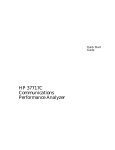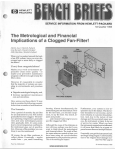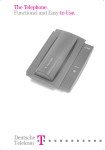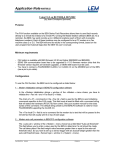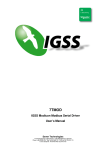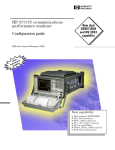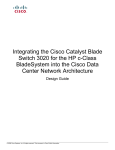Download SONET/SDH TEST SETS - Helmut Singer Elektronik
Transcript
SONET/SDH TESTSETS Communications Performance Analyzers, SDH/PDHTest Set HP377178,37717C,37724A . Single-unitsolution tor SDH/PDH/ATM Test. endiitter generation . and test In-service end out-ot-service measurements . Monitors PDHand SDHoverheadframing, parity, and alarm information . . Easy results interpretation with new color interface . ATM ce!! generation and analysis,and ATM services Ilyertest . Pointer sequence generationto ITU-T G.783 Works with HPE4540Adistributednetwork analysissoftware With compliments Helmut Singer Elektronik www.helmut-singer.de [email protected] fon +49 241 155 315 fax +49 241 152 066 Feldchen 16-24 D-52070 Aachen Germany HP37717C HP37717B/CCommunicationsPerformance Analyzers These offer modular, upgradeable one-box solutions tor installation, fjeld maintenance, commissioning and manufacturing. RIIgged and portable, they aIlowfullfunctional tesQngofSDH. PDH andATM equipment. includingjitter. The HP 37717C has color dispIay and grapbics IXinter. The HP3'Tl178 monochrome version provides a budget solution. wid1 a 2~lumn printer. 80th have a 3.>inch disk drive tor resu1ts retrievaI and storaae, finnware upgrades, and results export 10 ~ appIications. SDH -The SDH modules operate at STM-O. ~-1 and STM-4, with opa- ca!interfacesat 1310and 1550Dm.Combined with the structured PDH module.mux/demux BER tests from 622 Mb/s to n*64 kb/s Ire POIsible. In or out of service tests on PDH. SDH transmissionlines. or PDH payloadscarried in SOH systems,are supported.The operation of SOH networkaIanns,error monitors, protection switches.pointer processon and de-synchroniser circuits can be verified with this module. Drop/insertion of POH payloadsta/tram the SDH signal and an errat output are also available. SOH Alarm and ChannelScanfeatures make this product the industl'y standardtor easeof use. PDH. PDH rates of104kb/sand 2. 8. 34and 140Mb/saDdanerrorout. put are provided in the basic PDH module.The structured PDH module gives2, 8. 34 and 140Mb/s rates.The structured module provides funstructured PDH capability. including full mux/demux BER from 140 Mb/s to n*64 kb/s (n. 1 to 31). An alann scancapability graphically pointsto problem areaswithin the signal strocture; a telephonehandset connectionJives full talk/listen capability. Jitter end Wender - A range ot jitter modulesIives fuUPOH. SOH and ATM jitter generation/measurement 2, 8. 34, 140 Mb/s. 155 Mb/s (S'fM-l electrical and optical) and 622 Mb/s (STM-4optical) rates are sUPported. ]itter toleranceverification otSOH (mJ. T G.958/G.825)and PDH (rru-T G.823) network elements is pouible. Tests are made accordingto mJ. T 0.171 and can measurethe larre jitter transientsthat accompanypointer movements in SOH networks. Generate pointer sequences(to mJ- T G.783), wirb the appropriateSOHmodule.and meaSurethe effecton the tributary outputs using the tributary jitter measure- ment module.Wandergenerationavailableat 2Mb/s, STM-1,and STM-4. Wander measurement is available at 2 Mb/ s. ATM Cell and ServicelayerTest The ATM cell module gives transmit-and-receive capability at the physica! and ceU layers. and through mode monitor for convenient acces5. The ATM selvices module, avaiIable in the HP 37717C. fully tests B.ISDN pro. tocol stack layers. See page 454. DistributedNetwork Analysis Use with the HP E4540A distributed network analysis software. to create a results managementand remote instrument control system. (Seepage439.) Specifications Interfaces UPDH: 0.7.2.8.34.and 140Mb/sto 6.703 SPOH: 2, 8, 34, and 140 Mb/s tu 6.703 SOH: STM-oe, STM-le, STM-Go,STM-10, STM-40 (1310 and 1550nml ATM: OSI. 0S3 end 2, 34 and 140Mb/s, STM-le, STM-10 end STM-40 See page 454, tor ATM Cell and Services Specifications. OrderingInfonnation HP37717B/CCommunicationAnalyzers Accessoriel HP15744AOptical Power Coupler HP 1577OARack-mountKit HP 15772AHard RobustTransit Case HP E4540AOistributed NetworkAnalysis Software HP 15910ASoft Vinyl CarryingCase HP37724ASDH/PDHTestSet The HP 37724Ais a comprehensivefjeld portableSDH/PDH test set for applicationsfrom 2 Mb/ s (El) up to 622Mb/ s (SI"M-4). Ordering Information HP 37724A SOH/POH Test Set About the HP 37717C Instrument Options Instrument Options The HP 37717C is a multi-rate bit error measuring test set. It can generate and receive a range of data patterns, and provide analysis to ITU-T Rec. G.821, G.826, M2100, M2110, M2120 depending on the options fitted. 75 Ω unbalanced data interfaces are provided at all PDH / DSn data rates (except DS1, option UKZ) and STM-1 only. In addition 120 Ω balanced data interfaces are provided at 2.048 Mbit/s (and 704 kb/s in Option UKK [USB]). 100 Ω balanced data interface is provided for DS1 (UKZ only). AMI, HDB3, B8ZS or CMI coding is used depending on the selected rate. Accurate error measurements can still be made in the presence of half-rate cable loss of up to 12 dB, and at protected monitor points. Option UKK[USB] provides unstructured PDH measurements at standard bit rates of 704 kbit/s, 2.048 Mbit/s, 8.448 Mbit/s, 34.368 Mbit/s and 139.264 Mbit/s. Frequency offset capability of ±100 ppm about the standard rates, is provided. At 704 kbit/s and 2.048 Mbit/s the generator timing can be recovered from the received data. In-Service FAS measurements are available at 2 Mb/s 8 Mb/s, 34 Mb/s and 140 Mb/s. Option UKJ [USA] provides structured PDH generation and measurement at standard bit rates of 2.048 Mbit/s, 8.448 Mbit/s, 34.368 Mbit/s and 139.264 Mbit/s. Full Mux/Demux testing from 64 kb/s to 140 Mb/s including N X 64 kb/s, 2 Mb/s, 8 Mb/s and 34 Mb/s. Frequency offset capability of ±100 ppm about the standard rates, is provided. At 2.048 Mbit/s the generator timing can be recovered from the received data. Option UKN (USE) provides ATM generation and measurement at the Physical and Cell layers at bit rates of 2.048 Mb/s, 34.368 Mb/s, 139.264 Mb/s and if an SDH option is fitted 155.52 Mb/s. Option UKZ provides ATM generation and measurement at the Physical and Cell layers at bit rates of 1.544 Mb/s (DS1), 44.736 Mb/s (DS3), 2.048 Mb/s (E1) and 34.368 Mb/s (E3). SDH/SONET rates are available via an SDH optional module. Option USK Provides ATM Services layer generation and measurement with selectable header, payload and distribution for 1 foreground and up to 9 background channels. Graphic displays of the trafic at a point in the network, rate history and 2 About the HP 37717C Instrument Options cell delay variation are provided. AAL-1, AAL-3/4 and AAL5 sublayer measurements are also included. Option 0YK Provides broadband auxiliary ATM generation and measurement with selectable header, payload and distribution for 1 foreground and up to 9 background channels. Graphic displays of the trafic at a point in the network, rate history and cell delay variation are provided. AAL-1, AAL-3/4 and AAL5 sublayer measurements are also included. Option UHC (US6) Provides 3 additional data outputs, which are a replica of PDH Signal Out, each delayed by a defined amount. Option US1[US5] provides generation and analysis of mapped, 140 Mb/s, 34 Mb/s and 2 Mb/s, SDH signals at STM-1 (155.52 Mb/s). Errors can be added to the mapped payload. A frequency offset capability is provided, allowing the SDH line rate frequency to be offset from its synchronized rate. In addition the capability of generating SDH Alarms and Errors is available. Option A1T[A1U] provides the capability of US1[US5] and allows generation of ITU-T G.783 Pointer sequences and access to Overhead at STM-1 including Overhead Sequence generation and Capture. Option URU provides a STM-1/STM-4 optical interface at 1550 nm, for long reach applications. Option UKT provides a STM-1/STM-4 optical interface at 1330 nm with access to STM-4 overhead and Optical power measurement. Option USN provides a STM-1/STM-4 optical interface at 1330 nm and 1550 nm with access to STM-4 overhead and Optical power measurement. Option OYH provides binary interfaces for Options UKT and USN only. Option UHK Adds Jitter generation at all PDH rates except 704 kb/s if a PDH option is fitted, and if Option US1[US5] or A1T [A1U] is fitted adds Jitter generation at STM-1/STM-4. Option UHN [US9] Adds PDH Jitter measurement at all PDH rates except 704 kb/s, and adds Wander and Estimated Slips measurement at 2.048 Mb/s. Option A1M [A1Q] adds Jitter measurement at STM-1 Electrical rate and all PDH rates except 704 kb/s. Option A1N [A1R)]adds SDH Jitter measurement at STM-1 Electrical and Optical rate and all PDH rates except 704 kb/s. Option A1P [A1S] adds SDH Jitter measurement at STM-1 and STM-4 Optical rates, STM-1 Electrical rate and all PDH rates except 704 kb/s. 3 About the HP 37717C Instrument Options Option A3B provides an external printer port and remote control via RS-232-C, HPIB and LAN. Option A3D provides an external printer port and remote control via RS-232-C and HP-IB. Option USS provides Distributed Network Analyser capability. Option UKX provides an in lid printing facility. 4 About the HP 37717C Instrument Options Option Summary The following table provides a summary of the available HP 37717C options. Standard options are fitted with BNC connectors. Options identified in [ ] have Siemens connectors. Option No. Description UKK [USB] Unstructured PDH generation and measurement. UKJ [USA] Structured PDH generation and measurement. UKL [USC] Structured PDH measurement only. (No Longer available). UKN [USE] ATM generation and measurement. UKZ ATM generation and measurement at DS1, DS3, E1 and E3 rates. USK ATM Services layer generation and measurement 0YK Broadband auxiliary ATM generation and measurement UHC [US6] Multiple PDH outputs. US1 [US5] Generation and analysis of STM-1 electrical SDH signals, SDH frequency offset and Alarm/Error generation. A1T [A1U] As US1[US5] plus Pointer generation and Overhead access. UH1 STM-1 Optical interface at 1310 nm.(No Longer available). UH2 STM-1/STM-4 Optical interfaces at 1310 nm.(No Longer available). URU STM-1/STM-4 Optical interfaces at 1550 nm. UKT STM-1/STM-4 Optical Interface at 1310 nm, STM-4 overhead access and Optical power measurement. USN STM-1/STM-4 Optical Interface at 1310/1550 nm STM-4 overhead access and Optical power measurement. 0YH SDH binary interface for Option UKT and USN only. UH4 FC/PC optical adaptor for options UH1, UH2 and URU. UH5 DIN47256 optical adaptor for options UH1, UH2 and URU. UH6 ST optical adaptor for options UH1, UH2 and URU. UH7 Biconic optical adaptor for options UH1, UH2 and URU. 5 About the HP 37717C Instrument Options Option No. 6 Description UH8 NEC D4 optical adaptor for options UH1, UH2 and URU. UHK Jitter generation. UHN [US9] PDH Jitter measurement, Wander and estimated Slips. A1M [A1Q] STM-1 Electrical and PDH Jitter measurement. A1N [A1R] STM-1 Optical an electrical and PDH Jitter measurement. A1P [A1S] STM-1 Optical and Electrical, STM-4 Optical and PDH Jitter measurement. A3B Remote Control via RS-232-C, HP-IB and LAN, plus a Parallel Printer Port. A3D Remote Control via RS-232-C and HP-IB, plus a Parallel Printer Port USS Distributed Network Analyser capability. UKX In-lid Printer 1A8 Remote Control via HP-IB. (No Longer available). 1CW Remote Control via RS-23-C. (No Longer available). 1F7 Remote Control via LAN. (No Longer available). USE Virtual Remoter capability. OB2 Provides one additional operating manual. OBF Provides one additional remote control manual. OB3 Provides a service manual. W30 Provides two additional years of hardware support beyond the standard one year warranty. Jitter Modules Introduction to Jitter Introduction to Jitter Errors will occur in a digital signal if jitter at the input of Network Equipment exceeds a threshold value. It is important to check that the maximum input jitter, that can be tolerated by that equipment, meets the ITU-T standards for maximum tolerable input jitter. Excessive jitter not only causes errors, alarms and loss of synchronization but directly affects quality of service within the network. During the transition from a PDH network to mixed PDH/SDH networks, tight control of jitter levels is essential, especially as new sources of jitter emerge, caused by the mapping process and network synchronization problems resulting in pointer movements. The pointer movements cause tributary jitter at the PDH output ports of the network element. Cascading SDH regenerators on long distance links makes a build up of jitter unavoidable. It is vital to keep the jitter accumulation at the line side of the network element to a minimum as the SDH line rate is increasingly being used for synchronization purposes within SDH networks. Excessive line jitter may cause timing problems between network elements resulting in errors and pointer movements. ATM network elements such as switches, routers, multiplexers and cross connects are also susceptible to jitter and it is therefore important to minimize jitter in ATM networks. Wander is an extremely slow variation in the timing of the pulse stream. Excessive amounts of wander in a network will cause timing problems resulting in pointer movements. Wander measurements are made at 2 Mb/s, using an external 2 Mb/s MTS (ITU-T G.811) as a reference. Estimated frame and bit slips are also indicative of wander effects. The HP 37717C provides comprehensive Jitter testing at all PDH and SDH rates from 2 Mb/s to 622.08 Mb/s (STM-4). 2 Jitter Modules HP 37717C Jitter Measurement HP 37717C Jitter Measurement Four Jitter measurement options are available according to your testing needs. Option UHN [US9] PDH Jitter Measurement Option UHN provides Jitter measurement at PDH rates of 2 Mb/s, 8 Mb/s, 34 Mb/s and 140 Mb/s. To measure jitter connect the PDH signal to the PDH IN port of the PDH module (Options UKK, UKJ and UKN). The following Jitter measurements are available at all PDH rates: Jitter Hit Count Jitter Hit Seconds Jitter Hit free Seconds Peak Jitter (Positive and Negative) Peak to Peak Jitter The following Wander measurements are only available at 2.048 Mb/s: Peak Wander (Positive and Negative) Peak to Peak Wander Estimated Bit Slips Estimated Frame Slips A graphical display of Wander is also provided. DEMOD OUT connector provides a Demodulated Jitter output. Option UHN [US9] 3 Jitter Modules HP 37717C Jitter Measurement Option A1M [A1Q] PDH & STM-1 Electrical Jitter Measurements Option A1M provides Jitter measurement at STM-1 Electrical rate and PDH rates of 2 Mb/s, 8 Mb/s, 34 Mb/s and 140 Mb/s. To measure jitter connect the PDH signal to the PDH IN port of the PDH module (Options UKK, UKJ and UKN) or the STM-1 Electrical signal to the STM-1E IN of the A1M module. The following Jitter measurements are available at all PDH rates and STM-1 Electrical rate: Jitter Hit Count Jitter Hit Seconds Jitter Hit free Seconds Peak Jitter (Positive and Negative) Peak to Peak Jitter The following Wander measurements are only available at 2.048 Mb/s: Peak Wander (Positive and Negative) Peak to Peak Wander Estimated Bit Slips Estimated Frame Slips A graphical display of Wander is also provided. DEMOD OUT connector provides a Demodulated Jitter output Option A1M [A1Q] 4 Jitter Modules HP 37717C Jitter Measurement Option A1N [A1R] PDH & STM-1 Optical & Electrical Jitter Measurements Option A1N provides Jitter measurement at STM-1 Optical and electrical rate and PDH rates of 2 Mb/s, 8 Mb/s, 34 Mb/s and 140 Mb/s. To measure jitter connect the PDH signal to the PDH IN port of the PDH module (Options UKK, UKJ and UKN) or the STM-1 Electrical signal to the STM-1E IN of the A1N module or the STM-1 Optical signal to STM-1 IN of the A1N module. The following Jitter measurements are available at all PDH rates and STM-1: Jitter Hit Count Jitter Hit Seconds Jitter Hit free Seconds Peak Jitter (Positive and Negative) Peak to Peak Jitter The following Wander measurements are only available at 2.048 Mb/s: Peak Wander (Positive and Negative) Peak to Peak Wander Estimated Bit Slips Estimated Frame Slips A graphical display of Wander is also provided. DEMOD OUT connector provides a Demodulated Jitter output. Option A1N [A1R] 5 Jitter Modules HP 37717C Jitter Measurement Option A1P [A1S] (PDH, STM-1 Electrical &Optical &STM-4 Optical Jitter Measurements Option A1P provides Jitter measurement at STM-1 Optical rate, STM-4 Optical rate and PDH rates of 2 Mb/s, 8 Mb/s, 34 Mb/s and 140 Mb/s. To measure jitter connect the PDH signal to the PDH IN port of the PDH module (Options UKK, UKJ and UKN) or the STM-1 Electrical signal to the STM-1E IN of the A1P module or the STM-1/STM-4 Optical signal to STM-1/STM-4 IN of the A1P module. The following Jitter measurements are available at all PDH rates, STM-1 Optical rate and STM-4 Optical rate: Jitter Hit Count Jitter Hit Seconds Jitter Hit free Seconds Peak Jitter (Positive and Negative) Peak to Peak Jitter The following Wander measurements are only available at 2.048 Mb/s: Peak Wander (Positive and Negative) Peak to Peak Wander Estimated Bit Slips Estimated Frame Slips A graphical display of Wander is also provided. DEMOD OUT connector provides a Demodulated Jitter output. Option A1P [A1S] 6 Jitter Modules HP 37717C Jitter Measurement Option A3L [A3M] PDH & STM-1 Electrical Jitter Measurements Option A3L provides Jitter measurement at STM-1 Electrical rate and PDH rates of 2 Mb/s, 8 Mb/s, 34 Mb/s and 140 Mb/s. Compliance to ITU-T O.171 and testing to ITU-T G.825/G.958 is provided. To measure jitter connect the PDH signal to the PDH IN port of the PDH module (Options UKK, UKJ and UKN) or the STM-1 Electrical signal to the STM-1E IN of the A3L module. Jitter measurements are available at all PDH rates and STM-1 Electrical rate: Jitter Hit Count Jitter Hit Seconds Jitter Hit Free Seconds Peak Jitter (Positive and Negative) Peak to Peak Jitter Peak rms Jitter Automatic Jitter Transfer with narrowband selective filtering, in conjunction with Option UHK or A3K, Jitter Generation. The user can control the number of frequency points at which Jitter is generated, up to 55. Fixed input masks, ITU-T G.823 for PDH and ITU-T G.958 for SDH, are provided. A user defined mask is also available. Jitter Transfer results are displayed in tabular form and in Graphical form. The ITU-T pass mask is also displayed on the graph. Wander measurements are only available at 2.048 Mb/s: Peak Wander (Positive and Negative) Peak to Peak Wander Estimated Bit Slips Estimated Frame Slips Implied Frequency Offset A graphical display of Wander is also provided. DEMOD OUT connector provides a Demodulated Jitter output. Option A3L [A3M] 7 Jitter Modules HP 37717C Jitter Measurement Option A3V [A3W] PDH & STM-1 Optical & Electrical Jitter Measurements Option A3V provides Jitter measurement at STM-1 Optical and electrical rate and PDH rates of 2 Mb/s, 8 Mb/s, 34 Mb/s and 140 Mb/s. Compliance to ITUT O.171 and testing to ITU-T G.825/G.958 is provided. To measure jitter connect the PDH signal to the PDH IN port of the PDH module (Options UKK, UKJ and UKN) or the STM-1 Electrical signal to the STM-1E IN of the A3V module or the STM-1 Optical signal to STM-1/STM4 IN of the A3V module. Jitter measurements are available at all PDH rates and STM-1: Jitter Hit Count Jitter Hit Seconds Jitter Hit Free Seconds Peak Jitter (Positive and Negative) Peak to Peak Jitter Peak rms Jitter Automatic Jitter Transfer with narrowband selective filtering, in conjunction with Option A3K or UHK, Jitter Generation. The user can control the number of frequency points at which Jitter is generated, up to 55. Fixed input masks, ITU-T G.823 for PDH and ITU-T G.958 for SDH, are provided. A user defined mask is also available. Jitter Transfer results are displayed in tabular form and in Graphical form. The ITU-T pass mask is also displayed on the graph. Wander measurements are only available at 2.048 Mb/s: Peak Wander (Positive and Negative) Peak to Peak Wander Estimated Bit Slips Estimated Frame Slips Implied Frequency Offset A graphical display of Wander is also provided. DEMOD OUT connector provides a Demodulated Jitter output. Option A3V [A3W] 8 Jitter Modules HP 37717C Jitter Measurement Option A3N [A3P] PDH, STM-1 Electrical & Optical & STM-4 Optical Jitter Measurements Option A3N provides Jitter measurement at STM-1 Optical and electrical rate, STM-4 Optical rate and PDH rates of 2 Mb/s, 8 Mb/s, 34 Mb/s and 140 Mb/s. Compliance to ITU-T O.171 and testing to ITU-T G.825/G.958 is provided. To measure jitter connect the PDH signal to the PDH IN port of the PDH module (Options UKK, UKJ and UKN) or the STM-1 Electrical signal to the STM-1E IN of the A3N module or the STM-1/STM-4 Optical signal to STM-1/STM-4 IN of the A3N module. Jitter measurements are available at all PDH rates, STM-1 Optical and electrical rate and STM-4 Optical rate: Jitter Hit Count Jitter Hit Seconds Jitter Hit Free Seconds Peak Jitter (Positive and Negative) Peak to Peak Jitter Peak rms Jitter Automatic Jitter Transfer with narrowband selective filtering, in conjunction with Option A3K or UHK, Jitter Generation. The user can control the number of frequency points at which Jitter is generated, up to 55. Fixed input masks, ITU-T G.823 for PDH and ITU-T G.958 for SDH, are provided. A user defined mask is also available. Jitter Transfer results are displayed in tabular form and in Graphical form. The ITU-T pass mask is also displayed on the graph. Wander measurements are only available at 2.048 Mb/s: Peak Wander (Positive and Negative) Peak to Peak Wander Estimated Bit Slips Estimated Frame Slips Implied Frequency Offset A graphical display of Wander is also provided. DEMOD OUT connector provides a Demodulated Jitter output. Option A3N [A3P] 9 Jitter Modules HP 37717C Jitter Measurement Option UHK Jitter Generator Option UHK provides Jitter Generation at all ETSI rates, 2 Mb/s, 8 Mb/s, 34 Mb/s, 140 Mb/s, STM-1 and STM-4 depending on which PDH and SDH options are fitted. Allows the generation of User Definable Jitter as follows: Spot frequency Jitter within the ITU-T mask. Swept frequency Jitter within the ITU-T mask. Automatic Jitter Tolerance testing of PDH and SDH networks covering high and low Q systems using fixed jitter tolerance masks. Peak to Peak Jitter and Modulating frequencies as per ITU-T G.823 (PDH) and ITU-T G.958 (SDH). The Automatic Jitter Tolerance results are plotted in graphical form relative to the ITU-T mask. The User can control: the number of frequency points at which Jitter is generated, up to 55 the Dwell time - time taken at each frequency point the Delay time - time delay at each frequency point before jitter is generated the Bit error threshold - determines the threshold for the Jitter Tolerance PASS/FAIL decision. High or Low Q Factor selection (2 Mb/s and 8 Mb/s only) the type of mask A or B (SDH only) the Test Pattern Option UHK 10 Jitter Modules HP 37717C Jitter Measurement Option A3K [A3Q] Jitter & Wander Generator Option A3K provides Jitter Generation at all ETSI rates, 2 Mb/s, 8 Mb/s, 34 Mb/s, 140 Mb/s, STM-1 and STM-4 depending on which PDH and SDH options are fitted. Allows the generation of User Definable Jitter including Automatic Jitter Tolerance as detailed for Option UHK. The jitter modulation can be sourced internally or from an External source. The external modulation is connected to the MOD IN port. Allows testing to ITU-T G.825. Full ITU-T O.171 generation capability from 10 μΗz to 5 MHz Provides stimulus for Jitter Transfer measurements. Peak to Peak Jitter and Modulating frequencies as per ITU-T G.823 (PDH) and ITU-T G.958 (SDH). Provides Wander Generation at 2 Mb/s, STM-1 and STM-4 depending on which PDH and SDH options are fitted. An external clock must be connected to the 2M REF input. The 2M REF input can be used as an external clock for 2.048 Mb/s PDH transmission. The wander modulation can be sourced internally or from an external source. The external modulation is connected to the MOD IN port. Allows the generation of User Definable Wander as follows: Spot frequency Wander within the ITU-T mask. Option A3K [A3Q] 11 Jitter Modules HP 37717C Jitter Measurement Option 140 [141] Extended Jitter Generator Option 140 provides Jitter Generation at all ETSI rates, 2 Mb/s, 8 Mb/s, 34 Mb/s, 140 Mb/s, STM-1 and STM-4 depending on which PDH and SDH options are fitted. Allows the generation of User Definable Jitter including Automatic Jitter Tolerance as detailed for Option UHK. The jitter modulation can be sourced internally or from an External source. The external modulation is connected to the MOD IN port. Allows testing to ITU-T G.825. Full ITU-T O.171 generation capability from 10 μΗz to 5 MHz Provides stimulus for Jitter Transfer measurements. Peak to Peak Jitter and Modulating frequencies as per ITU-T G.823 (PDH) and ITU-T G.958 (SDH). The 2M REF input can be used as an external clock for 2.048 Mb/s PDH transmission. Option 140 [141] 12 HP 37717C PDH / DSn Features Introduction to PDH / DSn Introduction to PDH / DSn The Plesiochronous Digital Hierarchy (PDH / DSn) is still the dominant technology in most existing telecommunications networks throughout the world, although it is being replaced in many networks by Synchronous Digital Hierarchy (SDH) or SONET networks. PDH / DSn networks were developed at a time when point-topoint transmission was the predominant network requirement. To support this requirement, the standard approach to network management and maintenance was to use manual distribution frames for access to individual signals. This is now considered out of date and consequently SDH / SONET is now the preferred network topology for new installations. However PDH / DSn networks will exist for a long time to come even in networks where SDH /SONET is the preferred technology. PDH is the ETSI international standard, based on 2 Mb/s, defined by the ITU-T, and covers the hierarchal transmission rates of 2 Mb/s, 8 Mb/s, 34 Mb/s and 140 Mb/s. DSn is the ANSI standard covering transmission rates of 1.544 Mb/s (DS1) and 44.736 Mb/s (DS3). PDH is asynchronous at 8 Mb/s, 34 Mb/s and 140 Mb/s. In order to access a signal, for rerouting or test purposes, the whole line signal structure must be demultiplexed step by step down to the 2 Mb/s level, because of the asynchronous nature of the multiplexing. At each multiplexing step, the bit rate of the individual tributary signals is controlled within specified limits and is not synchronized with the multiplex equipment. Because the bit rates of the individual tributaries are controlled within specific limits this type of multiplexing is referred to as Plesiochronous i.e. nearly synchronous. The individual tributaries are synchronized with the equipment at each multiplex step by the process of positive bit stuffing justification. In new SDH / SONET networks, PDH / DSn signals are mapped into virtual containers / tributaries before being transported as part of the SDH / SONET payload. The SDH / SONET payload must then be demapped into a PDH / DSn tributary signal. Therefore all PDH / DSn, SDH / SONET and mixed PDH/SDH DSn / SONET networks require test sets which have PDH / DSn interfaces and PDH / DSn test capability. 2 HP 37717C PDH / DSn Features Options With PDH / DSn Capability Options With PDH / DSn Capability Unstructured PDH Generation and Measurement. Option UKK (USB) Option UKK (USB), Unstructured PDH, provides generation and measurement of unstructured PDH at interface rates of 704 kb/s, 2.048 Mb/ s, 8.448 Mb/s, 34.368 Mb/s and 139.264 Mb/s. Allows the addition of Frequency Offset to the PDH signal Provides 75 Ω unbalanced or 120 Ω balanced input and output interfaces. Allows selection of PRBS, WORD or USER patterns Allows selection of Line Code AMI, HDB3 or CMI Provides an ECL pulse each time an error occurs (Error Out) 3 HP 37717C PDH / DSn Features Structured PDH Generation and Measurement. Options UKJ (USA) and UKN (USE) Structured PDH Generation and Measurement. Options UKJ (USA) and UKN (USE) Options UKJ (USA) and UKN (USE), provide generation and measurement of Structured or Unstructured PDH at interface rates of 2.048 Mb/s (E1), 8.448 Mb/s (E2), 34.368 Mb/s (E3) and 139.264 Mb/s (E4). Structured test signal rates of 64 kb/s, 2.048 Mb/s, 8.448 Mb/s and 34.368 Mb/s are provided. Frequency Offset can be added at the interface rates. Line rate frequency can be measured. Provides 75 Ω unbalanced or 120 Ω balanced input and output interfaces. Allows selection of PRBS, WORD or USER patterns Allows selection of Line Code AMI, HDB3 or CMI Interface and test signal rates can be Framed or Unframed MUX connector allows a 2 Mb/s signal from external equipment to be inserted into the HP 37717C test signal. DEMUX connector allows a 2 Mb/s signal from the HP 37717C to be Dropped to external equipment. Option UKN (USE) also provides generation and measurement of PDH signals with ATM payloads. Option UKN (USE) therefore provides all of the PDH facilities described here with the additional facilities described on page 6. Information on the ATM capabilities of the UKN (USE) module is given in “The ATM Operating Manual” Option UKJ (USA) 4 HP 37717C PDH / DSn Features DS1, DS3, E1 and E3 Transmit and Receive Interfaces for ATM Payloads. Option UKZ DS1, DS3, E1 and E3 Transmit and Receive Interfaces for ATM Payloads. Option UKZ Option UKZ, provides generation and measurement of PDH /DSn signals with ATM payloads at interface rates of: 1.544 Mb/s (DS1), 44.736 Mb/s (DS3), 2.048 Mb/s (E1), and 34.368 Mb/s (E3). Frequency Offset can be added at the interface rates. Line rate frequency can be measured. Provides the following RZ input and output interfaces: DS3 and E3: 75 Ω unbalanced E1: 75 Ω unbalanced, 120 Ω balanced. DS1: 100 Ω balanced. Allows selection of Line Code as AMI, HDB3, B3ZS or B8ZS Provides Input sensitivity level selection. Provides output level control for DS1 and DS3. Allows error and alarm injection at the physical and ATM layers. Allows selection of PCLP or Direct mapping at DS3. Information on the ATM capabilities of this module is given in “The ATM Operating Manual” 5 HP 37717C PDH / DSn Features E1, E3 and E4 Transmit and Receive Interfaces for ATM Payloads. Option UKN (USE) E1, E3 and E4 Transmit and Receive Interfaces for ATM Payloads. Option UKN (USE) Option UKN (USE) provides generation and measurement of PDH signals with ATM payloads at rates of 2.048 (E1), 34.368 (E3) and 139.264 (E4) Mb/s. Frequency Offset can be added at the interface rates. Line rate frequency can be measured. Provides the following input and output interfaces: E1: RZ, 75 Ω unbalanced and 120 Ω balanced. E3: RZ, 75 Ω unbalanced. E4: CMI 75 Ω unbalanced. Allows selection of E1 Line Code AMI, HDB3. Allows selection of CRC-4 Multiframe at E1. Information on the ATM capabilities of this module is given in “The ATM Operating Manual” 6 HP 37717C PDH / DSn Features Binary Interfaces. Option UH3 (US7) Binary Interfaces. Option UH3 (US7) Option UH3 (US7) provides binary NRZ interfaces for the structured PDH module option UKJ (USA), and the unstructured PDH module option UKK (USB). The interfaces can operate at any of the standard rates ± 100 ppm. When used with option UKK (USB), with an external binary clock input, the interfaces can operate at any rate any rate in the range 700 kb/s to 170 Mb/s. TTL signal levels, at data and clock ports, and external clock port, are valid from 700 kb/s to 50 Mb/s, 75Ω to ground. ECL signals, at data and clock ports, and external clock port, are valid from 700 kb/ s to 170 Mb/s, 75Ω to -2V. The external clock input may be used to clock coded data from the PDH / DSn transmitter at standard rates. In addition if Option UKK (USB), Unstructured PDH, is fitted can clock coded data in the range 700 kb/s to 170 Mb/s. Simultaneous jitter of binary clock and binary data outputs is possible (2, 8, 34 & 140 Mb/s) if Option UHK (USB) or A3K, Jitter Generator, is fitted. Jitter measurement on the binary clock input is possible (2, 8, 34 & 140 Mb/s ±;100 ppm) if Option UHN, A1M, A1N or A1P, Jitter Measurement, is fitted. Frequency measurement of the external clock input and binary clock input is provided. 7 HP 37717C PDH / DSn Features Multiple PDH Outputs. Option UHC (US6) Multiple PDH Outputs. Option UHC (US6) Option UHC (US6), Multiple PDH Outputs, provides three additional 75Ω PDH outputs. OUT 1 is delayed by 4 bits relative to the main PDH OUT. OUT 2 is delayed by 8 bits relative to the main PDH OUT. OUT 3 is delayed by 12 bits relative to the main PDH OUT. NOTE: When used with Option UKZ, multiple outputs are available at the 2 and 34 Mb/s E1 and E3 rates. 8



























